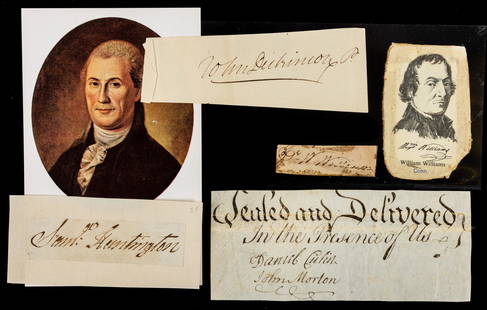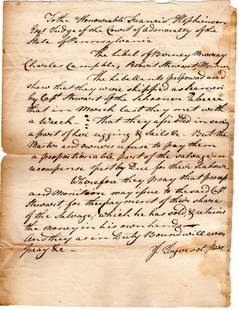
Sam Huntington, Declaration Signer, Seeks Arrest of
Similar Sale History
View More Items in Political MemorabiliaRelated Political Memorabilia
More Items in Political Memorabilia
View MoreRecommended Historical Memorabilia
View More





Item Details
Description
Sam Huntington, Declaration Signer, Seeks Arrest of Leaders of Shays’ Rebellion
[SHAYS’ REBELLION]. The Connecticut Journal, March 21, 1787. New-Haven: Thomas Green and Samuel Green. 4 pp., 9.75" x 15.5" Tears on folds and some edge tears; some text loss affecting five lines on p3.
This issue includes a February 26 proclamation by Connecticut Governor Samuel Huntington regarding the apprehension of the leaders of Shays’ Rebellion in neighboring Massachusetts. Pennsylvania President Benjamin Franklin signed a similar proclamation for that state on March 10, 1787.
Excerpts
“WHEREAS I have received official information, that the General Court of the Commonwealth of Massachusetts on the fourth day of instant February, declared, that a horrid and unnatural REBELLION and WAR, had been openly and traiterously raised and levied against that Commonwealth, with a design to subvert and overthrow the continuation and government thereof; and that Daniel Shays, of Pelham, and Luke Day of West Springfield, in the county of Hampshire; Adam Wheeler, of Hubbardston, in the county of Worcester, and Eli Parsons, of Adams, in the county of Berkshire, all in the Commonwealth of Massachusetts, have been the principals in, and abettors and supporters of this unnatural, unprovoked and wicked Rebellion....” (p1/c1)
“And also, whereas, I have received official application, from his Excellency Governor Bowdoin, in pursuance of the desire of the said General Court, requesting that the said Daniel Shays, Luke Day, Adam Wheeler, and Eli Parsons (they having absconded) may be apprehended, if to be found within this State, and rendered to justice in the said Commonwealth....” (p1/c1)
“I HAVE therefore thought fit, by and with the advice of Council, to issue this Proclamation, hereby requiring all Judges, Magistrates, Justices of the Peace, Sheriffs, Constables, and other proper officers, civil and military, within this State, to use their utmost endeavours for apprehending the said Daniel Shays, Luke Day, Adam Wheeler, and Eli Parsons...and them...to deliver up to some proper officer within the said Commonwealth, so that they may be rendered to justice.” (p1/c1)
Historical Background
Daniel Shays of central Massachusetts and other veterans of the American Revolutionary War left the army unpaid and returned home to face court actions for non-payment of debts, especially taxes. After the war’s end in 1783, many other veterans could not pay their taxes or money they owed on land purchased before the war.
In August 1786, protests in rural Massachusetts turned to direct action to prevent courts from sitting and were successful in Northampton. Governor James Bowdoin (1726-1790) issued a proclamation condemning such mob action. Shays had participated in the Northampton protest and took on a larger role as the movement grew. The Supreme Judicial Court of Massachusetts indicted eleven leaders of the rebellion, including Shays. The court was scheduled to meet in Springfield on September 26. Local militia commander William Shepard organized a militia to defend the court, and Luke Day led the protestors, who demonstrated but made no attempt to seize the court building. The court adjourned two days later without hearing any cases. Protestors also successfully prevented courts from sitting in Great Barrington, Concord, and Taunton, though courts met in larger towns and cities with militia protection.
Bowdoin suspended habeas corpus, and the legislature passed a Riot Act and other legislation against the insurgents. The arrest of some rebellion leaders in eastern Massachusetts led those in the western part of the state to speak of overthrowing the state government by mid-January 1787. Bowdoin created a privately funded militia under the leadership of former Continental Army General Benjamin Lincoln. Shays, Day, and other rebel leaders in western Massachusetts organized their forces with the idea of seizing the federal arsenal in Springfield, with its supplies of weapons and ammunition. General William Shepard took possession of the armory under orders from the governor but without the permission of Secretary of War Henry Knox.
The rebels executed an uncoordinated attack on the armory on January 25, 1787, and Shepard’s cannon fired grape shot, killing four rebels and wounding twenty more. The rebel advance collapsed, and the rebel forces retreated north and regrouped at Amherst. General Lincoln marched west from Worcester with his force of three thousand militia, while the rebels retreated north and west to Petersham. On February 4, Lincoln’s forces surprised the rebel camp there and scattered them.
Most of the rebel leaders fled north into New Hampshire and Vermont, where they found shelter, despite several demands that they be returned to Massachusetts for trial. The Massachusetts government offered a reward of $750 for the capture of Daniel Shays, and $500 each for Luke Day, Adam Wheeler, and Eli Parsons. Ultimately, four thousand Massachusetts men signed confessions acknowledging participation in the rebellion in exchange for amnesty.
Eighteen leaders were convicted and sentenced to death, but most of these sentences were overturned on appeal or commuted, or the prisoners were pardoned. On December 6, 1787, two leaders, John Bly and Charles Rose, were hanged. His handling of the rebellion made Bowdoin unpopular, and John Hancock easily defeated him in the gubernatorial election of 1787.
Daniel Shays (c. 1747-1825) received a pardon in 1788 and returned briefly from Vermont to Massachusetts before moving to New York. Authorities captured Luke Day (1743-1801) in Westmoreland, New Hampshire, in February 1787 and imprisoned him in Boston. He was released and granted a pardon in March 1788. Adam Wheeler (1732-1802), a veteran of both the French and Indian War and the Revolutionary War, fled to Canada and remained there until 1791, when he returned to Massachusetts after the town of Hubbardston settled his debt. Eli Parsons (1748-1830) was also a veteran of the Revolutionary War and also fled to Canada. He eventually received amnesty and settled in New York.
Additional content includes a recipe for making tanners bark (p1/c2); the judge’s charge to a grand jury in Albany, New York, in light of Shays’ Rebellion: “Suffer me yet again, to impress on your minds, that on a due and regular administration of justice, your lives, your liberties, your all depend.... To be convinced of this, we need only advert to the melancholy situation of a neighbouring state, where a mistaken multitude have arisen against government in a hostile manner, and pointed their impious arms against the courts of justice.... Nor are these the only evils attendant on political convulsions, foreign enemies may take the advantage of the confusion, and by siding with one part of the contenders, make an easy conquest of the whole.” (p1/c3); news from Norfolk, Savannah, Philadelphia, Providence, Boston, and New York (p2/c1-3), including Massachusetts Governor Bowdoin veto of a bill lowering his salary (p2/c2-3); along with other notices and advertisements.
The Connecticut Journal (1775-1809) was a weekly newspaper published in New Haven by brothers Thomas Green (1735-1812) and Samuel Green (1743-1799) of a distinguished family of printers and editors. The Green family founded or had an early part in the first five newspapers published in Connecticut. The Connecticut Journal continued the Connecticut Journal and New-Haven Post-Boy (1767-1775), also published by the Greens. The newspaper strongly supported the Patriot cause in the American Revolution. There were slight changes in its name until 1809, when it became the Connecticut Journal and Advertiser.
This item comes with a Certificate from John Reznikoff, a premier authenticator for both major 3rd party authentication services, PSA and JSA (James Spence Authentications), as well as numerous auction houses.
WE PROVIDE IN-HOUSE SHIPPING WORLDWIDE!
Buyer's Premium
- 25%
Sam Huntington, Declaration Signer, Seeks Arrest of
Shipping & Pickup Options
Item located in Westport, CT, usPayment

Auction Curated By






















![[Declaration Signers] Thomas Lynch (attrib.): [Declaration Signers] Thomas Lynch (attrib.), Cut signature attributed to Declaration of Independence signer Thomas Lynch, mounted on sheet of paper, along with a handwritten note from Samuel Hamilton](https://p1.liveauctioneers.com/188/286333/151508961_1_x.jpg?height=310&quality=70&version=1682334231)









![Declaration Signer William Williams Scarce War Dated DS: Williams William Declaration Signer William Williams Scarce War Dated DS A partly printed land grant signed on the verso "W. Williams" done on the "forth [sic] day of February, 1777". The document gra](https://p1.liveauctioneers.com/6306/158354/79957261_1_x.jpg?height=310&quality=70&version=1577465723)










![[CIVIL RIGHTS]. Double-sided memorial banner featuring Martin Luther King, Jr., and John F. Kennedy.: [CIVIL RIGHTS]. Double-sided memorial banner featuring Martin Luther King, Jr., and John F. Kennedy. 18 1/4 x 12 in. two-sided felt banner with machine-stitched binding on one side (very minor wear to](https://p1.liveauctioneers.com/197/329785/177758437_1_x.jpg?height=310&quality=70&version=1715625218)


















